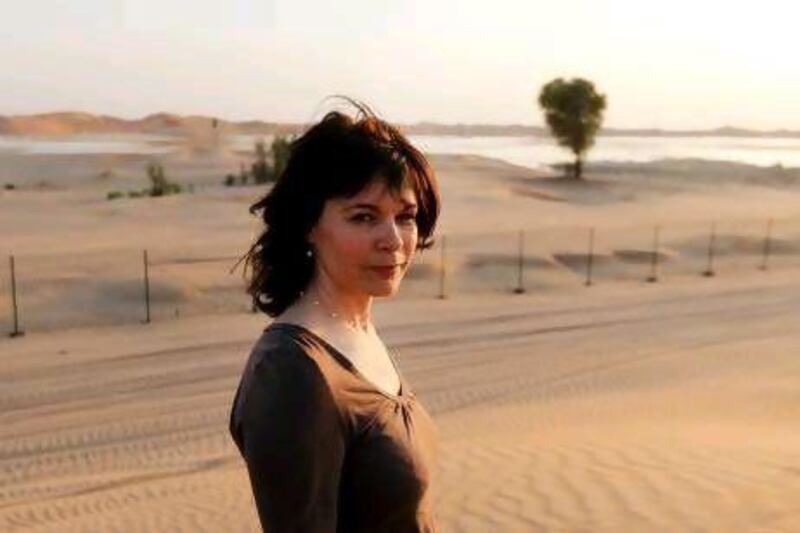It is almost sunset, and in the middle of rolling, rust-coloured dunes on the outskirts of Al Ain, a beautiful lake shimmers in the early evening light.
Migrant birds call to each other as they rest on the reeds, and in the surrounding dunes lizards, snakes, insects and gerbils make their nocturnal appearance.
With Jebel Hafeet looming in the distance it is quite a sight, but the lake's very existence in such an arid sandscape has made it a subject of mystery for some time.
Called Zakher Pools by nature-lovers, Quad Lake or Sand Dune Lake by dune-bashing enthusiasts, Tilapia Lake by anglers and Al Qusais Lake by the local authorities, this body of water first appeared eight years ago.
While some came from rising groundwater, others thought it to be natural spring water or simply run-off of a nearby wastewater-treatment plant.
In the past month a fence has been built around its perimeter to deter visitors attracted by its beauty, and since March the lake has shrunk by as much as a quarter.
Now the story of how the lake originated can be told, along with its future and how a natural ecology forced to adapt to its presence is threatened once more.
The story starts in 2004 when, according to a report from Al Ain Municipality, the city was struggling to deal with excess water.
"Groundwater levels in some areas rose to nearly a half metre from the land surface, leading to water appearing in the cellars of houses, posing a threat to the foundations and concrete infrastructures of the city," says the report, written in the past month by the department of infrastructure coordination.
"This caused projects to be disrupted because of the need to dry out excavations. It also caused the problem of water stagnation - a major environment hazard."
With complaints of flooding from residents and businesses, the municipality formed a committee to study Al Ain's groundwater.
The hydrologist Dave Clark, who worked on an Abu Dhabi research programme with the US Geological Survey, says Al Ain is unique in the UAE, where groundwater levels have dropped significantly.
"Al Ain's water levels have risen dramatically since 2004 for a variety of reasons. A new desalination line coming in from Fujairah, for example, doubled the amount of water," Mr Clark says.
And unlike other emirates that dump their sewerage in the sea, Al Ain's inland location and dated plants left the city with too much water on its hands.
"The sewage-treatment plant in Al Ain was built over 30 years ago and has been over capacity by two or three times for the last 10 years," Mr Clark says.
"They didn't have the infrastructure to pump the water to where it was needed so the authorities were dumping treated sewage water in Wadi Al Ain, because they had an excess capacity in the winter time and the pipes couldn't hold it."
With so much water in the system, traditional wells were abandoned for the mains water supply. One result was that gardens and parks were over-watered, leaving underpasses flooded and infrastructure developments in jeopardy.
The municipality's solution was to shift some of the excess to a new location, 29 kilometres south of downtown Al Ain and just off the Al Ain-Abu Dhabi Truck Road.
The plan worked, temporarily easing the overloaded system.
By 2008, low rainfall and lorries pumping water out of the lake each day to irrigate local farms meant the lake had virtually disappeared.
"You could almost drive across it," recalls Mr Clark.
Then, in December 2009, the city experienced 120 millimetres of rainfall in one day - far more than the average of 100mm a year - swelling the lake to more than 1.2 million square metres, with depths of up to 20 metres.
"At that point the water levels in a certain point of Al Ain rose enough to get into the storm sewer and there was a constant flow of water into the lake," says Mr Clark, who retired last month.
But while the original intention was to use the lake as a basin for stormwater relief, not all of the water was excess rainwater.
The municipality report says the lake was also used "as a point to pile products of the drying operations for Abu Dhabi Sewerage Service Company. Water was pumped from the worksites on the rainfall drainage system, and thus to the lake".
Recent municipality tests on the water found high rates of salinity, concluding its source was groundwater with "no trace of treated water".
Mr Clark and his team, who carried out independent tests, dispute that.
"The water changed over time," he says. "Early on there was treated sewage water going into the lake but later that stopped. However, people dump things in the storm sewer so there were hydrocarbons and things like that going in there.
"It was salty water and hadn't been fresh for a long time. At one point the salinity was really high and the last time I checked it had started dropping, so there was obviously water coming in from different sources."
Whatever the source, the lake did not go unnoticed, first attracting the attention of passing wildlife and later humans.
Up to 200 different species of bird have since been seen, including migrating herons and ducks that are never normally seen in the desert, which had stopped to rest and even breed.
With the birds came tilapia, a freshwater fish that can also survive in brackish water such as that of Al Qusais lake.
Some anglers believed they were deliberately placed there by the municipality to keep the mosquito population down, but Mr Clark says birds could have hooked the eggs, which lie in the shallows on the edge of a lake, in their feet and carried them from one body of water to another.
While the new ecosystem was welcomed by nature lovers, however, not everyone was happy.
"In terms of ecology it's a disaster," says Brigitte Howarth, an ecological entomologist in the college of sustainability sciences and humanities at Zayed University. "Yes, it has created a temporary respite for migratory birds but it has also compromised the natural habitat."
Ms Howarth has worked in the UAE for the past 14 years, studying insects native to the UAE but also surveying the lake and its effects on the natural habitat.
"You have a whole ecosystem around the sand dunes and the plants and trees that is extremely delicate and species numbers are high," she explains.
At the bottom of the food chain are the insects. Ms Howarth made one of her biggest discoveries at the site - the unusual practice of the midas fly, a species rarely seen in the UAE, which lays its eggs an inch under the sand's surface by walking backwards up the dunes.
The assistant professor also monitors the longhorn beetle, which flourishes only in natural ghaf forests. No evidence can be found of the beetle in the ghaf trees that have been irrigated by the lake.
"This water is changing the whole ecosystem," Ms Howarth says. "The evaporation of the water creates a huge amount of humidity but the eggs are adapted to a desert environment. This intrusion is not going to help the species here."
She is also concerned that ancient archaeology in the dunes is being lost. She points to pottery shards lying in the sand, an indication of the continual occupation of the dunes, and tells of having found mother of pearl, used as jewellery, at the same spot.
"There was a lot more but this new road around the new fence may have affected it," Ms Howarth adds.
With litter strewn around the dunes, the human intrusion is clear to see. For some time, the lake has been mentioned on blogs as a must-see destination for birdwatchers, visitors and quad bikers keen to get a glimpse of the "sparkling blue" waters.
Anglers also came and friends gathered to unwind in the peaceful setting.
But its popularity quickly led to problems. Two swimmers have drowned there in recent months - a girl from Palestine and a man from Kashmir - and the cars of many adventurers have been stuck in the sludgy sand after they ventured too close to the water's edge.
However, it was not only the deaths that concerned the authorities. The lake's growth was threatening to flood the nearby lorry road, so it was decided to fence it off and turn off the sluice feeding it.
The report states: "To avoid damage to the surrounding facilities, drowning incidents, the extension of water body that reached 100 metres from the main road, precautionary measures were taken."
These precautionary measures included testing the water and "addressing Abu Dhabi Sewerage Service Company to stop pumping into the rainfall-drainage system, and to pump instead in the sewerage system to be treated and reused in cosmetic industries".
The third measure was to monitor the lake's levels, which the report says decreased 22 per cent between March and July this year.
Visitors to the site last week were ordered away by a security guard and a man driving a 4x4, but lorries pumping out water were still allowed access.
With the sluice turned off, the lake receding and the water unreachable for nature lovers, what will happen to the lake is unclear.
But if it disappears, the birds will stop coming and the fish will continue to die. Their skeletons can be seen where the water has already receded.
With two new treatment plants in development, it appears the municipality no longer needs to deposit water in this natural basin.
"There were other lakes and most have dried up," says Mr Clark. "The authorities have changed their system and no longer need to dump this water. They are more efficient."
With the desert likely to reclaim the land, how the natural habitat will respond is also difficult to measure.
Ms Howarth adds: "If it was left in peace it would eventually come back, but a habitat takes thousands of years to recover and I'm sure we're not going to give this habitat that amount of time."






